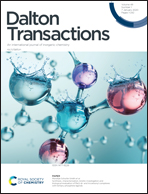Low-temperature synthesis of nanoscale ferromagnetic α′-MnB†
Abstract
The search for tunable, size-dependent properties and unique processability has triggered the development of new synthetic routes for transition metal borides. MnB is a soft to semi-hard ferromagnetic material. This boride is now available by bottom-up, low-temperature solution chemistry. It is obtained as an unexpected metastable α′-variant that crystallises with a stacking-fault dominated CrB-type structure, as shown by transmission electron microscopy and X-ray powder diffraction (space group Cmcm, a = 300.5(8), b = 768.6(2), and c = 295.3(4) pm). The nanostructured powder consists of agglomerates of small particles (mean diameter of 85(41) nm) and transforms into well-known β-MnB with FeB-type structure at 1523 K. The room temperature ferromagnetic behavior (TC = 545 K) is attributed to the positive exchange–correlation between the manganese atoms, that have many unpaired d electrons.



 Please wait while we load your content...
Please wait while we load your content...